know the law
Page 59

If you've noticed an error in this article please click here to report it so we can fix it.
by Les Oldridge, AMIRTE, 11,11MI
Insurance obligations
SECTION 143 of the Road Traffic Act 1972 makes it an offence to use, or cause or permit to be used, a motor vehicle on a road unless there is in force in relation to the user of the vehicle a policy of insurance for third party risks in respect of the death of, or of bodily injury to, any person caused by, or arising out of, the use of the vehicle on a road. The policy must also cover the cost of emergency medical or surgical examination or treatment needed after an accident. There is no statutory requirement to insure against damage to property, other vehicles or one's own vehicle although it is obviously prudent to do so.
There are certain minor exemptions to the requirements of this section. Invalid carriages, vehicles owned by the police and local authorities are among those exempt. As an alternative to an insurance policy the requirements of the Act are met if £15,000 is deposited with the Accountant General of the Supreme Court.
There is a defence, of particular importance to the employed driver, to the offence of using a vehicle while not insured. He cannot be convicted if he proves that he was using the vehicle in the course of his employment and that he neither knew nor had reason to believe that the vehicle was not insured. This special defence for employees does not preclude the conviction of the employer for causing or permitting the offence. There is a maximum penalty of three months' imprisonment and/or a £50 fine. An offender's driving licence may be suspended and it will be endorsed unless there are "special reasons" for this not being done.
Since December 1 1972 the Motor Vehicles (Passenger Insurance) Act 1971 has been in operation. This Act requires users of motor vehicles to be covered against any liability which might occur in respect of the death or personal injury to their passengers while the vehicle is being used on a road. Any agreement made between the driver and his passengers that the latter are carried at their own risk will be of no effect after that date.
The Motor Vehicle (Third Party Risks) Regulations 1972 effective from November 1 1972 makes minor amendments to the law concerning insurance. These are the Regulations which deal with certificates of insurance, cover notes, certificates of security, deposit and ownership. Cover notes are the documents issued as a temporary measure until the policy and certificate have been prepared. This often takes some weeks and the cover note, which is issued more or less on demand, allows the vehicle to be taken into immediate use. Cover notes do not cover any period of time before they are made out. The case of Smith v Alexander and Alexander (1965) 1 Lloyds Rep 283 (1967) illustrates this. "A" was driving "B's" car at 6.05 pm on March 25 when he was stopped by the police and asked for an insurance certificate. At 6.30 pm the same day "B" completed an insurance proposal form and was issued with a cover note expressed to be effective from 6.45 pm that day. Later the policy was issued stating that the insurance commenced on March 25. "A" and "B" argued that the policy was effective from 12.01 am on March 25 but it was held that this was not so and that they were not covered at the time the car was stopped by the police. In Cartwright v McCormack (1963) All E.R. 416 it was decided that a cover note expires at midnight on the specified date irrespective of the time of commencement.
It will be noticed that the offence of not having insurance cover relates to "using" motor vehicle and not necessarily driving it. In Milstead v Sexton (1964) Crim L.R. 474, for example, it was held that a vehicle being towed is being used and must be insured. A similar decision was reached in Elliott v Gray (1960) I Q.B. 367. In this case a vehicle had been jacked up in the road outside a house so that its wheels were off the ground; the battery had been removed so that it was impossible to start the engine. Nevertheless, it was held that the vehicle was being used on a road and was required to be covered by a policy of insurance.
Unauthorized use
There is. some interesting case law concerning the unauthorized use of vehicles by employees. In John T. Ellis v Hinds (1947) KB. 475 it was held that if an employee is using the vehicle on his own, account without authority the employer has neither caused nor permitted the use of the vehicle. In Marsh v Moores (1949) 2 All ER. 27 a motor vehicle was being driven by a servant on a journey for his employer. The driver took his girl friend along with him and allowed her to steer the vehicle while he sat beside her ready to apply the handbrake. It was held, on appeal, that if a policy covers employees, driving by one of them in a unauthorized manner but within the scope of his employment, will normally be covered by insurance and the insurance offence was not committed. If the journey was unauthorized or not within the scope of the servant's employment, eg he had gone "joy riding" without his employer's permission, the position would have been different.
I have dealt only with the requirements of the Road Traffic Act where insurance is concerned. The fleet operator will need several other types of insurance cover, eg insurance of goods in transit — but this subject is outside the scope of this article.




































































































